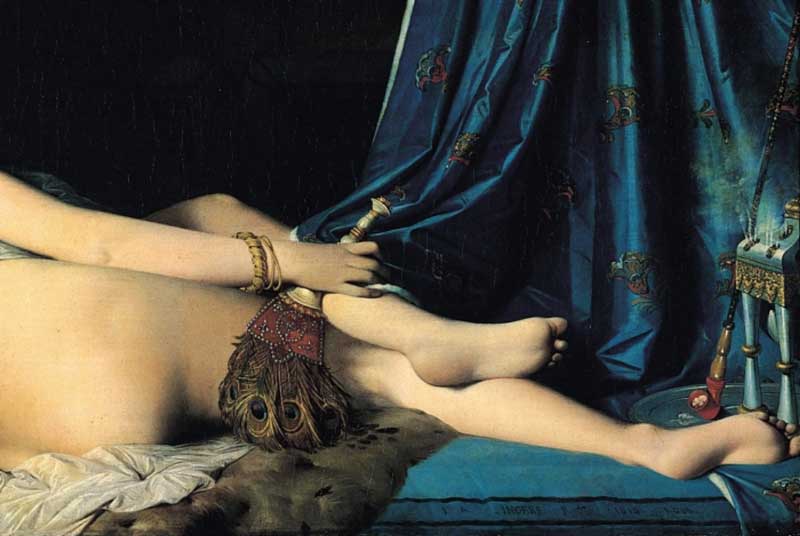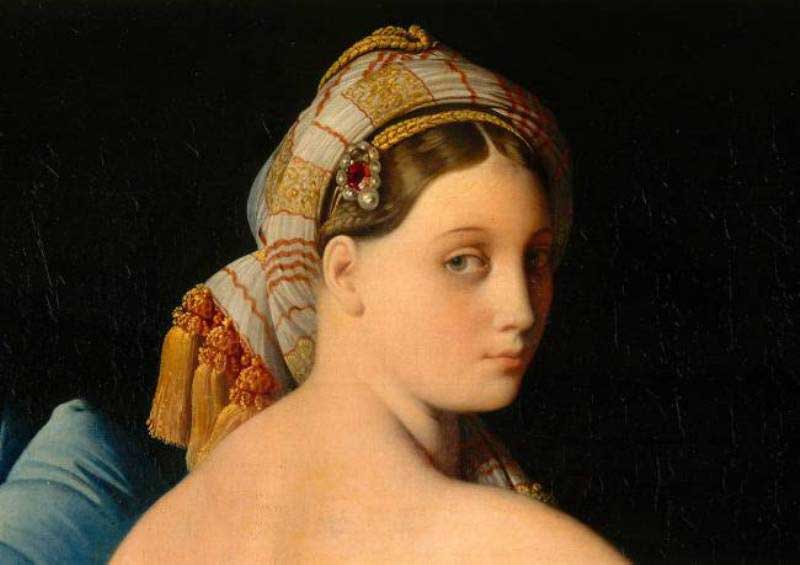
Jean-Auguste-Dominique Ingres, the French Neoclassical painter, was commissioned by Napoleon’s sister Caroline Murat, the queen of Naples, in 1814 for a composition to be complementing to his earlier composition La Dormeuse de Naples, portraying a nude sleeping woman of Naples. Accordingly, Ingres completed his Grande Odalisque in 1814, but due to the unexpected collapse of the regime, Ingres received no payment for the work.
Odalisque is a Turkish word that stands for a chambermaid or female attendant in a Turkish harem, especially in the house of the Ottoman sultan. In his composition Ingres portrayed a reclining odalisque, as seen from behind with distorted proportions of her small head, elongated limbs and lack of anatomical realism. The whole scene is occupied by the nude woman, who wears nothing other than a turban, decorated with ruby and pearl encrusted broach in her hair and a gold bracelet on her right wrist. In her right hand she holds a peacock fan, a symbol of affluence and along the right side of the composition lies a hookah or a pipe, used for smoking tobacco or hashish or opium. The shamelessly nude woman peeks over her shoulder, as if to look at someone, who she was expecting and who has just entered her room. However, her face seems aloof and without any sign of eager expectations.

La Grande Odalisque had to face harsh criticism when it was first exhibited in 1814 for combining classical form with Romantic themes and the contemporaries considered the work to signify Ingres’ break from Neoclassicism and a shift toward exotic Romanticism. When it was first shown in the Salon of 1819, it also caused an outrage, not for the brazen nudity of the odalisque, but because of the elongated proportions and lack of anatomical realism. It was pointed out that the figure was drawn with curvature of the spine, a distorted pelvis and the left hand shorter than the right. It was argued that, anatomically it is quite unlikely that her lower left leg could meet with the knee in the middle of the painting or that her left thigh attached to this knee could reach her hip. The figure was also described as neither having bones nor muscle, neither blood nor life.
However, the critics failed to understand the style of the artist. The distortions were done not because Ingres was ignorant of anatomy, but purely for stylistic effect. He intentionally distorted the female body to make her more sinuous and elegant. He significantly elongated the figure's torso to demonstrate that this is a fantasy woman in a land for fantasy and she is not a real nude woman.

Clearly, this is not a real life female body, it is the female body, as Ingres wished it to be. He created the Odalisque almost surreally curvy, impossibly waxen-skinned, yet more real than any photograph. She was created by the artist with long and sinuous lines, while her skin is bathed in a diffused soft light. Utterly amoral, this painting is a lascivious source of titillating delight.
It was argued that in depicting the reclining nude odalisque, Ingres was influenced by the famous works like, Sleeping Venus (1510) by Giorgione, Venus of Urbino (1538) by Titian, and Rokeby Venus (1641-51) by Velazquez. But the title of all those three paintings includes the word Venus, the goddess. The fact is, the nude was always a major theme in Western art, but it was common to cloak the paintings of the female nude in the disguise of classical mythology. However, Ingres had something else in his mind and instead of mythology, he transposed the theme to a distant land. He refused to disguise the nude woman under the veil of the goddess of love and beauty, he openly painted an odalisque, a concubine who lives in a harem and plays the role to satisfy the sexual pleasure of the sultan.
At the same time, he compels the viewer to be directed to the Orient, a far-away land, in the second decade of the nineteenth century. The nude woman with her peacock fan, her turban, the jewel encrusted broach in her hair, the hookah or the pipe for smoking and finally, the title of the painting, all refer to the conception of the Orient. Instead of mythology, Ingres covered his object of desire in a misty, distant exoticism.

Grande Odalisque was received more positively after the death of the painter. Later, it influenced great artists, like Degas and Picasso. Today, it is recognized as one of Ingres' most famous nudes and since 1899, it has been housed in the Louvre Museum.